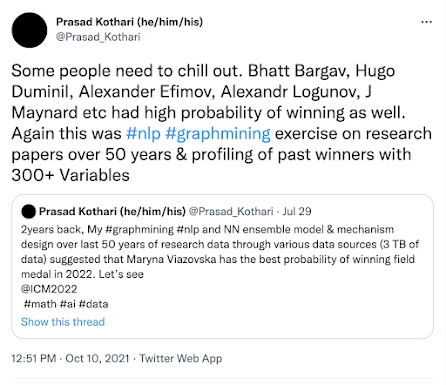This required a lot of
1. Data cleaning
2. Defining the breakthrough of every winner
3. Developing co-author network data
4. look-a-like profiling based on topics, citations, embeddings, and lot of other things
5. Developing topic models through natural language processing, the topology of networks, superimposing topology of networks with topics & changing the definition of a breakthrough with respect to the papers of the winners
6. Deep Divergence Learning & Ricci Flow for community detection for clustering right topics with unsupervised learning
7. Reinforcement learning & ensemble modeling
And A Secret recipe of this predictive analytics project which came through the concept of the topology of social networks & KBGAN: Adversarial Learning for Knowledge Graph Embeddings - https://arxiv.
8. Ant Colony Optimization to understand amongst research coauthors has the shortest path with innovation breakthrough yield & to win the Field..
My prediction came true for Maryana Viazovska, Hugo Duminil & J Maynard while Bhargav Bhatt won New Horizon breakthrough prize.
I am running the algorithms this time for 2026 and the initial analysis shows Lisa Piccirllio (comes first), Urmila Mahadev (comes 2nd), Melanie Weber, Shai Evra, W Sawin, Kaisa Matomaki, Adam Harper, Yifeng Liu, Dr. Tang's name have probability over 95% to win 2026 Field prize.






.jpeg)
.jpeg)
